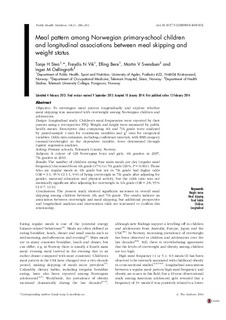| dc.contributor.author | Stea, Tonje Holte | |
| dc.contributor.author | Vik, Frøydis Nordgård | |
| dc.contributor.author | Bere, Elling | |
| dc.contributor.author | Svendsen, Martin Veel | |
| dc.contributor.author | Oellingrath, Inger Margaret | |
| dc.date.accessioned | 2018-01-18T12:02:18Z | |
| dc.date.available | 2018-01-18T12:02:18Z | |
| dc.date.created | 2014-02-19T14:14:19Z | |
| dc.date.issued | 2014 | |
| dc.identifier.citation | Public Health Nutrition. 2014, 18 (2), 286-291. | nb_NO |
| dc.identifier.issn | 1368-9800 | |
| dc.identifier.uri | http://hdl.handle.net/11250/2478138 | |
| dc.description.abstract | Objective: To investigate meal pattern longitudinally and explore whether meal skipping was associated with overweight among Norwegian children and adolescents.
Design: Longitudinal study. Children’s meal frequencies were reported by their parents using a retrospective FFQ. Weight and height were measured by public health nurses. Descriptive data comparing 4th and 7th grade were analysed by paired-sample t tests for continuous variables and x2 tests for categorical variables. Odds ratio estimates, including confidence intervals, with BMI category
(normal/overweight) as the dependent variable, were determined through logistic regression analyses.
Setting: Primary schools, Telemark County, Norway.
Subjects: A cohort of 428 Norwegian boys and girls; 4th graders in 2007, 7th graders in 2010.
Results: The number of children eating four main meals per day (regular meal frequency) decreased from 4th grade (47 %) to 7th grade (38 %; P50?001). Those who ate regular meals in 4th grade but not in 7th grade had higher odds (OR53?1; 95% CI 1?1, 9?0) of being overweight in 7th grade after adjusting for gender, maternal education and physical activity, but the odds ratio was not statistically significant after adjusting for overweight in 4th grade (OR52?8; 95% CI 0?7, 11?6).
Conclusions: The present study showed significant increases in overall meal skipping among children between 4th and 7th grade. The results indicate an association between overweight and meal skipping, but additional prospective and longitudinal analyses and intervention trials are warranted to confirm this relationship. | nb_NO |
| dc.language.iso | eng | nb_NO |
| dc.title | Meal pattern among Norwegian primary-school children and longitudinal associations between meal skipping and weight status | nb_NO |
| dc.type | Journal article | nb_NO |
| dc.type | Peer reviewed | nb_NO |
| dc.description.version | publishedVersion | nb_NO |
| dc.rights.holder | © The Authors 2014 | nb_NO |
| dc.source.pagenumber | 286-291 | nb_NO |
| dc.source.volume | 18 | nb_NO |
| dc.source.journal | Public Health Nutrition | nb_NO |
| dc.source.issue | 2 | nb_NO |
| dc.identifier.doi | 10.1017/S136898001400010X | |
| dc.identifier.cristin | 1116736 | |
| cristin.unitcode | 222,56,1,0 | |
| cristin.unitname | Institutt for sykepleie- og helsevitenskap | |
| cristin.ispublished | true | |
| cristin.fulltext | original | |
| cristin.qualitycode | 1 | |
